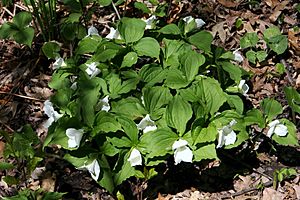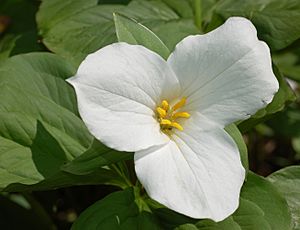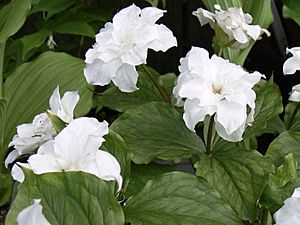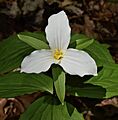White trillium facts for kids
Quick facts for kids White trillium |
|
|---|---|
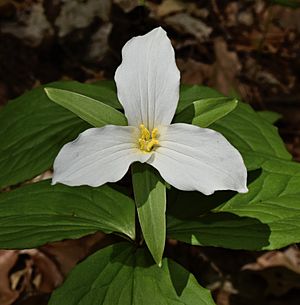 |
|
| The white trillium blooming in Backus Woods, Ontario, Canada. | |
| Conservation status | |
| Scientific classification | |
| Genus: |
Trillium
|
| Species: |
grandiflorum
|
The Trillium grandiflorum, also known as the white trillium or large-flowered trillium, is a beautiful flowering plant. It belongs to the Melanthiaceae family. This plant is a perennial (meaning it lives for more than two years) and grows from a rhizome (an underground stem).
You can find the white trillium naturally in eastern North America. It grows from northern Quebec in Canada, down through the Appalachian Mountains in the United States, all the way to northern Georgia. It also grows west to Minnesota. You can even find smaller groups of them in places like Nova Scotia, Maine, and Iowa.
This plant loves rich, mixed forests, especially those with deciduous trees (trees that lose their leaves in autumn). It's easy to spot because of its pretty white flowers, which have three petals. These flowers bloom from late spring to early summer. They grow above a whorl (a circle) of three leaf-like parts called bracts. The white trillium is a "spring ephemeral". This means it grows, flowers, and sets seeds quickly in spring before the forest trees grow their full leaves and block the sunlight.
White trilliums often grow in large, dense groups. For example, the G. Richard Thompson Wildlife Management Area in the Blue Ridge Mountains is famous for its huge display of white trilliums each spring. Near Linden, Virginia, along the Appalachian Trail, there are estimated to be nearly ten million white trillium plants blooming every year!
Contents
What Does the White Trillium Look Like?
The white trillium is a perennial plant that grows from a short rhizome (an underground stem). Each plant usually produces one showy white flower above a circle of three leaves. The flowering stems can grow to be about 20 to 40 centimeters (8 to 16 inches) tall.
The leaves are often called bracts because they are not true leaves from the main stem. The main stem is actually the rhizome underground. A single underground root can create many new plants, forming large and dense groups of trilliums.
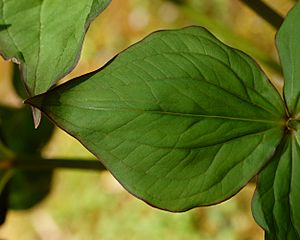
The flowers stand upright and don't have a smell. They are quite large compared to other Trillium species, with petals that can be 4 to 7 centimeters (1.5 to 2.7 inches) long. The petals are shaped a bit like the leaves and curve outwards. You can see veins on them, though not as clearly as on the leaves. Their curved, overlapping bases give the flower a unique funnel shape.
Between the petals, you can see three pointed green sepals. These are usually lighter green than the leaves and sometimes have maroon streaks. The flowers sit on a pedicel (a flower stalk), which lifts them above the leaves. As the flowers get older, their white petals often turn pink.
The flowers have six stamens (the parts that produce pollen) arranged in two groups of three. These stamens stay on the plant even after it produces fruit. The styles (part of the female reproductive organ) are white and very short. The anthers (the top part of the stamen) are pale yellow but become brighter when they release pollen. The ovary (where seeds develop) has six sides with three greenish-white stigmas (the part that receives pollen). The fruit is a green, round, and moist ball, which also has a slightly six-sided shape like the ovary.
Types of White Trillium
There is a special type of white trillium called T. grandiflorum f. roseum. This form opens with light pink petals instead of the usual white. It's quite rare to find, but in the Blue Ridge Mountains of Virginia, you might see it more often, sometimes even in groups of only pink trilliums.
It's important to know that the common white trillium flowers also turn a distinct pink color as they get older, just before they wilt. People often mistake these aging pink flowers for a special "pink variety" of trillium.
Sometimes, white trilliums can have green marks on their petals or even many extra petals or bracts (up to 30!). These unusual shapes are often caused by tiny organisms called phytoplasma, not by changes in the plant's genes. However, T. grandiflorum can sometimes naturally produce "double-flowered" forms, like T. g. f. polymerum. These double flowers are usually sterile, meaning they can't produce seeds. This species is the one that creates double flowers most often. Unlike some other trillium species, the white trillium is not known to mix with other species to form new types.
How White Trilliums Grow and Spread
The white trillium prefers soil that drains well and is neutral to slightly acidic. It often grows in younger or second-growth forests. In the northern parts of its range, it likes maple or beech forests, but it can also spread into open areas nearby.
Depending on where it grows, the white trillium flowers from late April to early June. Like many perennial forest plants, the white trillium grows slowly. Its seeds have "double dormancy," which means they usually take at least two years to sprout fully. The seeds are released in late summer. They need a cold period and then a warm period to sprout. After another winter, a tiny seedling emerges from the soil.
For a white trillium to start flowering, it needs to reach a certain size, not just a certain age. This usually means it needs at least 36 square centimeters (5.6 square inches) of leaf surface and 2.5 cubic centimeters (0.15 cubic inches) of rhizome volume. In nature, it typically takes 7 to 10 years for a white trillium to grow big enough to flower. However, if grown by people, they might flower faster, though this is not common.
Why Protecting White Trilliums is Important
The white trillium is very popular among gardeners who love trilliums. This is because of its large flowers and how relatively easy it is to grow. However, this popularity has led to worries about its protection. Most of the plants sold in stores are believed to be taken directly from the wild. This means they are not grown in nurseries.
Taking too many plants from the wild, along with other problems like forests being destroyed and deer eating the plants, can put the white trillium in danger in some areas. Because of this, some governments in Canada and the United States have listed the plant as vulnerable.
For example, in Quebec, Canada, T. grandiflorum is legally listed as vulnerable. This is mainly because its forest homes are being destroyed in areas where many people live. In Maine, USA, the plant is listed as possibly gone from the wild because it hasn't been seen there in over 20 years.
How White Trilliums Reproduce and Spread Seeds
For a long time, people thought white trilliums pollinated themselves because insects were rarely seen visiting them. However, studies have shown that bumblebees often pollinate them. Also, white trilliums are not very good at self-pollinating. This means they need help from pollinators to make seeds.
The fruits of the white trillium are released in the summer, and each fruit has about 16 seeds. These seeds are most often spread by ants. This process is called myrmecochory. Yellow jacket wasps and harvestmen (also known as "daddy longlegs") have also been seen moving the seeds, but less often.
Insects help spread the seeds because the seeds have a special, oil-rich part called an elaiosome. This elaiosome is full of fats and oleic acid. The oleic acid makes ants think the seeds are food, so they carry them back to their nests. As ants visit different trillium plants, they collect seeds from various plants and bring them to one spot. When these seeds sprout, they create a new group of plants with good genetic diversity, which helps the plants be stronger.
Even though ants are the main way seeds are spread, white-tailed deer have also been known to spread seeds sometimes by eating the fruits and then pooping out the seeds. Ants only move seeds about 10 meters (33 feet), but deer can carry them over 1 kilometer (0.6 miles)! This helps explain how white trilliums can grow in new forest areas after farms are gone. It also helps explain how genes can spread over long distances.
This long-distance spreading by deer is important for understanding how plants like the white trillium survived during the ice ages. During those times, glaciers covered much of the land. Plants that could only spread short distances would have struggled to move to new areas. So, occasional long-distance spreading by animals like deer likely helped save the white trillium and other plants from dying out during the ice ages. Studies show that white trilliums likely survived the last glacial period in two safe places in the southeastern United States. Long-distance spreading helped them move back to northern areas after the glaciers melted.
Besides spreading seeds horizontally (by insects and deer), it's also important that seeds get buried vertically. When ants (or other animals) bury the seeds, it helps new plants survive in two ways. First, burying the seeds deep enough protects them during their first year of dormancy. Second, burying them helps the rhizomes (underground stems) stay firmly in the ground. This is especially important for young plants, as their small rhizomes and short roots can easily be moved by things like frost or erosion.
White Trilliums and Deer
White trilliums, along with other trillium species, are a favorite food for white-tailed deer. If trilliums are available, deer will often choose to eat them, especially T. grandiflorum, before eating other plants. When deer browse (eat plants) normally, they tend to eat the larger trillium plants, leaving the shorter ones behind. Scientists can use this information to figure out how many deer are in an area and how they affect the growth of plants on the forest floor.
If deer eat too many plants, the trillium plants become shorter each year. This happens because they have less energy stored from not being able to do as much photosynthesis (making food from sunlight). One study found that the best number of deer in northeastern Illinois for healthy forest plants, using T. grandiflorum as a guide, is 4 to 6 deer per square kilometer. This is based on the idea that a healthy trillium stem should be about 12 to 14 centimeters (4.7 to 5.5 inches) tall.
However, in some areas where natural predators like wolves are missing, there can be as many as 30 deer per square kilometer. If there are too many deer for several years, it can seriously damage the plants on the forest floor and even cause some local plant populations to disappear.
Growing White Trilliums in Gardens
The white trillium is one of the most popular trilliums to grow in gardens. People love it because of its large flowers and how relatively easy it is to care for. However, growing it can be slow and sometimes tricky. This is because it usually grows slowly, and its seeds don't always sprout easily.
Because of these challenges, most of the white trillium plants and rhizomes sold are collected from the wild. As mentioned before, taking too many plants from the wild, along with habitat loss and deer eating them, can put the plants in danger in some areas. This creates disagreements between trillium fans and people who want to protect the plants.
Moving wild trillium plants to a garden is a delicate process, and many times, the plant will not survive. When grown in a garden, T. grandiflorum might flower in as little as 4 to 5 years after sprouting (compared to 7 to 10 years in the wild). However, this is not the usual case. One study found that out of about 10,000 seeds planted, only 20% sprouted after a year, and only about 20 plants grew very well. But once a white trillium starts flowering, it can continue to bloom every year if it's not harmed. It can survive cold winters in USDA zones 4-8.
A special type of double-flowered white trillium, called T. grandiflorum 'Pamela Copeland', was created at the Mt. Cuba Center and named after its founder, Mrs. Pamela du Pont Copeland. This plant has also won the Royal Horticultural Society's Award of Garden Merit, which is a special award for excellent garden plants.
Traditional Uses of White Trillium
Some Native Americans used to cook and eat the leaves of the white trillium. They also chewed the underground rootstalks for different medical purposes.
White Trillium in Culture
The large white trillium is a very popular American wildflower. It's the Trillium species that people who study nature often see and report.

Because it's such a noticeable forest flower, T. grandiflorum was chosen as the official provincial flower of Ontario, Canada, in 1937. It also became the state wild flower of Ohio, USA, in 1987. Professional soccer teams from Toronto and Columbus even compete for the Trillium Cup every year!
As an official symbol of Ontario, a stylized trillium flower is a big part of the wordmark (logo) of the Government of Ontario. It also appears on the official flag of the province's French-speaking minority. Government groups and programs often use the word "trillium" in their names, like the Trillium Gift of Life Network (which manages organ donation) and the Trillium Book Award (a yearly literary award from the provincial government). The Canadian Heraldic Authority also often uses the trillium to represent Ontario in official coats of arms.
While it's widely believed that picking trilliums in Ontario is illegal, it's actually against the law to pick any wildflowers on Crown (government-owned) or provincially owned land. It's not specifically illegal to pick a trillium, and doing so doesn't necessarily harm the species.
Images for kids
See also
 In Spanish: Trilio blanco para niños
In Spanish: Trilio blanco para niños



